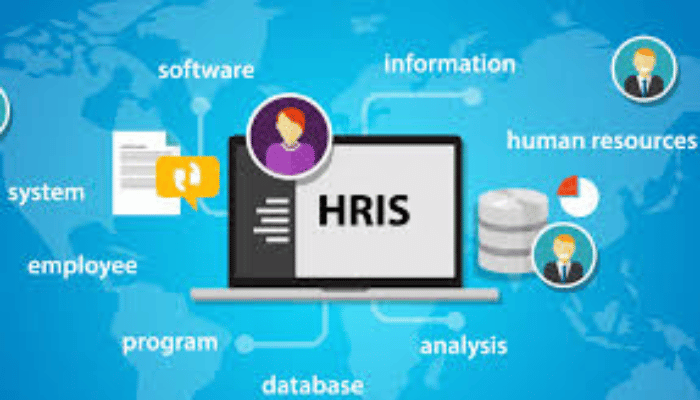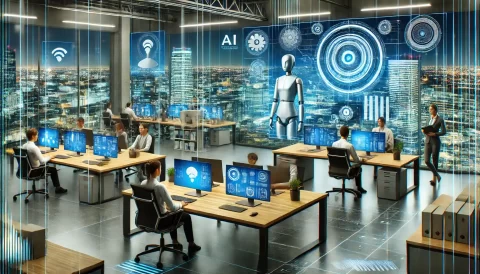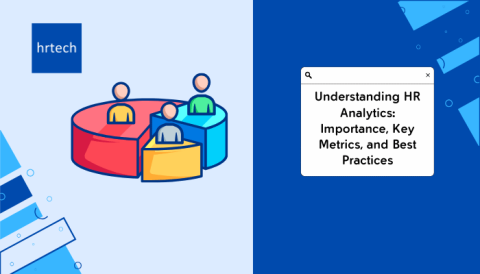Imagine managing your entire workforce on a single, streamlined platform. That’s the power of an HRIS (Human Resource Information System)! In today’s dynamic business landscape, where talent is king, a robust HRIS is a necessity.
But with a plethora of HRIS options on the market, choosing the right one can feel like navigating a tech labyrinth. Fear not, fellow HR warriors! We will equip you to compare HRIS systems like a pro, considering the latest features and trends shaping the future of HR in 2024.
Ever wondered…
How did HRIS systems evolve to meet the demands of modern workplaces?
What are the must-have HRIS features for 2024 and beyond?
What key criteria should guide your HRIS system selection process?
We’ll delve into these questions and more, providing valuable insights to help you select the perfect HRIS for your unique needs. Buckle up, and get ready to transform your HR operations!
Key Features to Look for in HRIS Systems:
Customizable Workflows & Streamlined Operations:
Gone are the days of one-size-fits-all HR solutions. Modern HRIS systems empower you to tailor workflows to your unique business processes. Imagine automating onboarding procedures, leave request approvals, or performance review cycles. This not only saves valuable time but also ensures consistency and reduces errors.
Ask yourself:
Can the HRIS adapt to my company’s specific needs and departmental structures?
Mobile Compatibility- A Must-Have for Accessibility:
Today’s workforce is mobile-first. Does your chosen HRIS offer a user-friendly mobile app allowing employees to access paystubs, request time off, or update personal information on the go? This fosters a culture of employee self-service and enhances overall satisfaction.
Consider:
Will a mobile app empower your geographically dispersed workforce to manage HR tasks seamlessly?
Third-Party Integrations & Ecosystem Harmony:
No HRIS exists in a vacuum. Ensure your chosen system integrates seamlessly with existing payroll providers, timekeeping tools, or learning management systems. Look for open-source API integrations to create a robust HR technology ecosystem that works together like a well-oiled machine.
Think about:
Will the HRIS integrate with your current HR tech stack, avoiding data silos and streamlining processes?
Advanced Analytics & Reporting: Data-Driven Decisions for a Competitive Edge:
HR is no longer just about administrative tasks. Modern HRIS systems provide powerful analytics tools that transform data into actionable insights. Use these insights to identify trends in recruitment, analyze performance metrics, or track employee engagement.
Question yourself:
Does the HRIS offer robust reporting features that help me make data-driven decisions for my workforce strategy?
Employee Self-Service Portals: Empowering Your Workforce
Empower your employees with a self-service portal! This online platform allows them to access payslips, update personal details, submit leave requests, or enroll in benefits – all at their convenience. This not only reduces HR workload but also fosters a sense of ownership and accountability among employees.
Consider the impact:
Will a self-service portal free up your HR team’s time for more strategic initiatives?
Automation in Payroll & Benefits Administration: Say Goodbye to Tedious Tasks
Let technology handle the heavy lifting! Look for HRIS features that automate payroll processing, tax calculations, or benefits administration. This frees up your HR team to focus on more strategic tasks, ensuring accurate and efficient employee payments and benefits management.
Think about the benefits:
Will automation in payroll and benefits administration alleviate the burden on your HR team, allowing them to focus on higher-level tasks?
By carefully considering these key features, you’ll be well-equipped to compare HRIS systems and choose the one that best empowers your team, streamlines your operations, and helps you build a future-proof workforce for 2024 and beyond.
Transforming HR through Agile Workforce Solutions.
Top HRIS Systems of 2024- An Overview:

With so many HRIS options available, navigating the selection process can feel overwhelming. Here’s a quick snapshot of some of the top contenders in 2024, highlighting their strengths to help guide your decision:
1. Rippling Unity:
Focus: Customizable Workflows
Why Consider: If streamlining your HR processes with personalized workflows is a priority, Rippling Unity might be your champion.
2. GoCo:
Focus: Employee Record-Keeping with Customizable Forms
Why Consider: GoCo excels in maintaining accurate and organized employee data with its customizable forms feature.
3. BambooHR Essentials:
Focus: Plug-and-Play Automations for Superior Employee Experience
Why Consider: BambooHR shines with its user-friendly interface and pre-built automations designed to enhance the employee experience.
4. ADP RUN Essential:
Focus: Mobile Payroll Completion
Why Consider: Need a mobile-first solution for payroll processing? ADP RUN Essential allows employees to access and complete payroll tasks conveniently on the go.
5. TriNet Zenefits Essentials:
Focus: Wide Range of Benefits Administration
Why Consider: If managing a complex benefits package is a challenge, TriNet Zenefits Essentials offers a comprehensive suite to simplify administration.
6. Gusto Simple:
Focus: Ideal for New Businesses
Why Consider: Just starting out? Gusto Simple offers a user-friendly and affordable HRIS solution tailored for the needs of new businesses.
7. Deel HR:
Focus: Optimal for Global HR Management
Why Consider: Managing a geographically dispersed workforce? Deel HR provides features specifically designed to streamline global HR processes.
8. Bob:
Focus: Employee Recognition and Support
Why Consider: Looking to boost employee morale and engagement? Bob prioritizes features that foster a culture of recognition and support within your organization.
Comparative Analysis and Pricing:
Now that you’ve explored key features and top contenders, let’s delve into the nitty-gritty: comparative analysis and pricing. This will empower you to make an informed decision that aligns with your specific needs and budget.
1. Comparison Chart and Feature Analysis
Here are some key areas to consider:
Core HR Functionality: Payroll processing, benefits administration, time tracking, performance management, etc.
Advanced Features: Customizable workflows, mobile accessibility, advanced analytics, employee self-service portals, etc.
Integrations: Compatibility with existing hrtech stack (payroll providers, learning management systems, etc.)
Scalability: Can the HRIS scale to meet your future growth needs?
2. Pricing Models and What They Offer:
HRIS pricing can vary depending on the vendor, features offered, and the number of employees you need to manage. Here are some common pricing models to consider:
Per User Per Month: A fixed cost per employee you manage using the HRIS system.
Tiered Pricing: Different pricing tiers with varying feature sets.
Transaction-Based Pricing: Costs may vary depending on the number of transactions processed (e.g., payroll runs, benefits enrollment).
3. Evaluating Cost-Effectiveness:
Remember, price shouldn’t be the sole deciding factor. Consider the long-term value proposition. A slightly higher upfront cost might be justified if the HRIS offers features that significantly improve HR efficiency, reduce administrative burden, or enhance employee engagement.
Here’s a pro tip: Leverage free trials or demos offered by many HRIS vendors. This allows you to test-drive the system and ensure it meets your needs before committing financially.
By combining a thorough feature analysis with a clear understanding of pricing models and cost-effectiveness, you’ll be well-equipped to choose the HRIS that delivers the best value for your organization. Stay tuned for our next blog post, where we’ll provide a downloadable comparison chart template to guide your HRIS selection process!
How to Choose the Best HRIS Systems
Now that you’re armed with knowledge on key features, top contenders, and comparative analysis, it’s time to choose the HRIS that perfectly complements your organization! Here’s a step-by-step guide to navigate the selection process:
1. Identifying Primary Problems and Objectives:
Start by taking a deep dive into your current HR operations. What are your biggest challenges? Is it streamlining onboarding, managing remote teams, or improving employee engagement? Identifying these pain points will help define your HRIS objectives.
2. Determining Key Users and Their Requirements:
Who will be the primary users of the HRIS? HR professionals, managers, or your entire workforce? Understanding their needs is crucial. Interview key users to capture their desired functionalities and identify any challenges they face with existing HR processes.
3. Assessment of Necessary Tool Integrations:
Does your HRIS need to seamlessly integrate with your existing payroll provider, timekeeping software, or learning management system (LMS)? Evaluating your current HR tech stack and identifying necessary integrations will streamline your workflow and avoid data silos.
4. Outlining Desired Outcomes and Success Measures:
What do you hope to achieve by implementing a new HRIS? Improved efficiency, reduced administrative burden, or better employee self-service? Define clear success metrics that align with your objectives. This will help you track progress and measure the impact of the HRIS on your HR operations.
5. Compatibility with Organizational Culture and Workflows:
Consider your company culture. Does it prioritize collaboration, agility, or data-driven decision-making? Choose an HRIS that aligns with your cultural values and complements your existing workflows. Don’t just automate processes for the sake of automation; ensure the new HRIS fosters a positive user experience.
Future Trends and Evolutions in HRIS:
The HRIS landscape constantly evolves, fueled by technological advancements and changing workforce needs. Here’s a peek into some exciting trends shaping the future of HRIS:
1. The Rise of AI and Machine Learning:
Get ready to see Artificial Intelligence (AI) and Machine Learning (ML) playing a more prominent role in HRIS. Imagine AI-powered chatbots answering employee questions, streamlining onboarding processes, or recommending personalized learning opportunities.
ML can analyze vast amounts of HR data to identify trends, predict employee turnover, or suggest targeted talent acquisition strategies.
2. Prioritizing Employee Engagement and Experience:
HRIS is no longer just about managing administrative tasks. The future shines a spotlight on employee engagement and experience. Look for HRIS features that promote recognition programs, facilitate peer feedback, or foster a sense of community within your organization.
3. User Experience (UX) Takes Center Stage:
A user-friendly HRIS is no longer a luxury, it’s a necessity. Expect HRIS systems to boast intuitive interfaces, mobile responsiveness, and gamification elements to encourage employee self-service and boost overall user satisfaction.
4. Advanced Data Analytics for Smarter Decisions:
HR is becoming increasingly data-driven. HRIS of the future will offer advanced analytics dashboards that provide real-time insights into workforce trends, employee performance, and talent development. This data will empower HR leaders to make informed decisions and optimize their HR strategies.
5. Data Security and Privacy: A Top Priority:
Data security and privacy will remain paramount as HRIS systems manage more sensitive employee data. Look for HRIS vendors that prioritize robust security measures, comply with data privacy regulations, and offer features like data encryption and access control.
Conclusion:
Here’s a quick recap to solidify your learnings:
Key Considerations: Customizable workflows, mobile compatibility, integrations, advanced analytics, employee self-service portals, and automation capabilities are all crucial features to evaluate during your HRIS selection process.
Top Contenders: Explore a diverse range of HRIS options, each with unique strengths. From Rippling Unity’s workflow mastery to Bob’s focus on employee recognition, there’s an HRIS perfectly suited to your specific needs.
Comparative Analysis: Don’t be afraid to roll up your sleeves and create a comprehensive comparison chart. Consider pricing models, feature sets, and how each HRIS aligns with your organizational culture and objectives.
The Future is Bright: The HRIS landscape is abuzz with exciting trends like AI, advanced analytics, and a laser focus on employee experience. Embrace these advancements to build a future-proof HR strategy for your organization.
At hrtech, we understand the complexities of choosing the right HRIS for your organization. That’s why we offer a comprehensive suite of resources to empower you throughout your journey.
First, equip yourself with knowledge. Our in-depth guide, “HRIS Showdown 2024: A Comprehensive Guide to Choosing the Best Fit for Your Workforce,” dives deep into everything you need to know. This valuable resource explores key features, compares leading HRIS options, and offers insights on navigating the selection process with confidence.
Next, explore your options. We showcase a diverse range of HRMS solutions designed to meet your specific needs. From core HR functionalities like payroll and benefits administration to advanced features like talent management and employee engagement, we have the perfect HRMS solution waiting to be discovered.
Finally, make an informed decision. If you get stuck along the way, don’t hesitate to leverage our expertise!
We offer free consultations with HR technology specialists who can provide personalized recommendations based on your unique needs.
Ready to transform your HR operations? Start your journey today!





